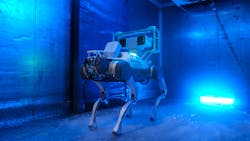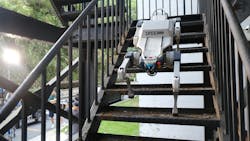Industry-Grade Quadruped Platform Breaks Limitations of Traditional Robots
Robotics can help streamline the manufacturing process and increase efficiency with assembly, packaging and material handling, but they also are being developed for industrial fields such as factory inspection and firefighting applications.
Deep Robotics developed the X30 quadruped robot for these types of applications. It utilizes advanced multi-sensing capabilities which allow the robot to navigate changing environments, maneuver over industrial stairs and operate autonomously in a range of conditions.
Power & Motion spoke with Peter Deng, product manager at Deep Robotics, to dive into the motivation behind the creation of the X30 quadruped robot as well as the challenges it aims to help overcome in industrial settings.
Editor’s note: Questions and responses edited for clarity.
Power & Motion: Why was the X30 quadruped robot developed, and what challenges does it help overcome?
Peter Deng: In industrial fields, such as power inspection, factory inspection, firefighting rescue, etc., we are constantly exploring areas and scenarios that traditional robot platforms are unable to reach. We have developed the X30, a next-generation industry-grade quadruped platform designed specifically for these scenarios.
X30 is a new generation of industry-level quadruped robot developed by Deep Robotics, which brings the world’s leading industry capabilities to meet the main demands of power stations, factories, pipeline corridors, as well as emergency rescue, fire fighting, future scientific research and other fields. The multi-sensing capabilities allow X30 to become the first to realize rapid and steady obstacle crossing in changing environments, up and down hollow industrial stairs, all-weather autonomy in the daytime and nighttime, breaking the limitations of more scenarios.
P&M: Can you give an overview of how the machine works?
PD: Deep Robotics developed these advanced algorithms to enable precise coordination and synchronization of movements among the 12 joints of the quadruped robot. This level of control allows for smoother and more efficient locomotion, as well as the ability to perform complex maneuvers and tasks.
These quadruped robots are equipped with advanced sensor systems, including but not limited to vision sensors, environmental sensors and proximity sensors. These sensors provide real-time feedback and enable the platform to perceive its surroundings, detect potential hazards and make informed decisions based on the gathered data.
The integration of mechanical arms further enhances the platform’s capabilities. It enables the robot to manipulate objects, perform complex tasks, and assist professionals in various industries such as power inspection, factory inspection and firefighting rescue.
By leveraging the capabilities of the quadruped platform, professionals can work more efficiently and safely in hazardous environments, reducing the risk of injuries and increasing productivity. Additionally, the combination of sensor technologies and navigation algorithms minimizes repetitive tasks, allowing professionals to focus on more complex and high-value activities.
READ MORE: Rapid Growth Ahead for Mobile Robot Components Market
P&M: Who are the target customers and what are the target industries for this robot?
PD: Power companies, factories, firefighting and emergency response departments, security agencies, logistics organizations and research institutions. We also target to personal users.
Target industries include power substations’ security inspection, underground pipelines and tunnels security inspection, industrial production areas and building surveying, and public rescue.
P&M: What general technologies help the robot move? What about those that enable its autonomous operation?
PD: Three motors on each robot leg give the robots strong adaptability and excellent dynamic balance ability.
Technologies that enable autonomous operation include four lidar [sensors] and one camera, two on the front of the robot and two on the back of the robot, combined with the navigation algorithm.
P&M: Are any hydraulic or pneumatic technologies used? If not, what technology in place of them are used?
PD: Electric. We have developed our own motors and combine different torque motors based on the structure and configuration locate[d] on [the] legs. For the cameras, we use an industrial-level wide FOV (field of view) camera. By integrating information from multiple sensors and utilizing advanced fusion techniques, we can effectively control the movement of the quadruped robot platform through low-level control. This enables us to overcome various terrains and obstacles encountered in real-world scenarios.
The fusion of sensor information enables the robot to perceive its environment accurately and make informed decisions regarding its movement. By combining data from sensors such as cameras, accelerometers, gyroscopes, and distance sensors, the robot can analyze the terrain, identify obstacles and adjust its motion accordingly.
P&M: What’s next for Deep Robotics?
PD: By [improving] AI (artificial intelligence) and machine learning algorithms, we believe that [we] will enable quadruped robots to learn and adapt in real-time, enhancing their ability to perform complex tasks and collaborate with humans. These robots will become more autonomous, assisting professionals in repetitive and physically demanding tasks, ultimately increasing productivity and reducing the risk of human error. We will keep looking for more practical applications that allow quadruped robots to be more deeply integrated into human society.
About the Author
Sharon Spielman
Technical Editor, Machine Design and Power & Motion
Sharon Spielman is a technical editor for Power & Motion and its affiliate publication Machine Design. As technical editor, her beat includes 3D printing/CAD; mechanical and motion systems, with an emphasis on pneumatics and linear motion; automation; robotics; and AR/VR.
Sharon has more than three decades of experience as a writer and editor for a range of B2B brands, including those that cover electrical design and manufacturing; interconnection technology; food and beverage manufacturing; process heating and cooling; finishing; and package converting.

Leaders relevant to this article:



